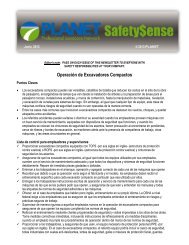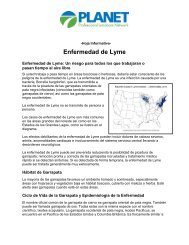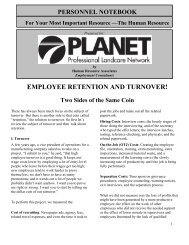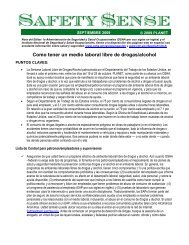Economic Impacts of the Green Industry in the - Urban Forest ...
Economic Impacts of the Green Industry in the - Urban Forest ...
Economic Impacts of the Green Industry in the - Urban Forest ...
You also want an ePaper? Increase the reach of your titles
YUMPU automatically turns print PDFs into web optimized ePapers that Google loves.
y <strong>Green</strong> <strong>Industry</strong> participants and those are listed where applicable. To ga<strong>in</strong> a common basis on which to<br />
perform a comparison <strong>of</strong> <strong>the</strong> results from each state, total population dur<strong>in</strong>g <strong>the</strong> year <strong>of</strong> <strong>the</strong> study is tabulated,<br />
along with each state’s Gross State Product (GSP). In concept, an <strong>in</strong>dustry’s GSP (or its value added) is equal to<br />
its gross output (sales or receipts and o<strong>the</strong>r operat<strong>in</strong>g <strong>in</strong>come, and <strong>in</strong>ventory change) m<strong>in</strong>us its <strong>in</strong>termediate <strong>in</strong>puts<br />
(use <strong>of</strong> goods and services purchased from o<strong>the</strong>r U.S. <strong>in</strong>dustries or imported). Thus, <strong>the</strong> GSP accounts provide<br />
data by <strong>in</strong>dustry and state that are consistent with <strong>the</strong> Nation’s gross domestic product (GDP) by <strong>in</strong>dustry<br />
accounts. However, total GSP for <strong>the</strong> Nation differs from GDP <strong>in</strong> <strong>the</strong> national <strong>in</strong>come and product accounts for<br />
three reasons. First, like <strong>the</strong> national estimates <strong>of</strong> GDP by <strong>in</strong>dustry, GSP is measured as <strong>the</strong> sum <strong>of</strong> <strong>the</strong><br />
distributions by <strong>in</strong>dustry <strong>of</strong> <strong>the</strong> components <strong>of</strong> gross domestic <strong>in</strong>come. Second, GSP excludes (and GDP by<br />
<strong>in</strong>dustry <strong>in</strong>clude) compensation <strong>of</strong> Federal civilian and military personnel stationed abroad and government<br />
consumption <strong>of</strong> fixed capital for military structures located abroad and for military equipment, except<br />
domestically located <strong>of</strong>fice equipment. Third, GSP and GDP <strong>of</strong>ten have different revision schedules.<br />
Table 1-2 also <strong>in</strong>cludes an estimate <strong>of</strong> <strong>the</strong> calculated share <strong>of</strong> each state’s GSP that <strong>the</strong> <strong>Green</strong> <strong>Industry</strong> represents;<br />
an unadjusted <strong>Green</strong> <strong>Industry</strong> sales (impact) per capita calculation; and an adjusted sales (impact) per capita<br />
estimate. This adjusted sales impact <strong>in</strong>volves multiply<strong>in</strong>g each unadjusted per capita estimate by <strong>the</strong> respective<br />
GDP implicit price <strong>in</strong>flator for each respective year to convert all per capita estimates to 2004 dollars. As shown<br />
<strong>in</strong> <strong>the</strong> table, economic impacts estimated <strong>in</strong> <strong>the</strong> selected studies ranged from $186 million <strong>in</strong> Massachusetts and<br />
Vermont to a high <strong>of</strong> $10.3 billion <strong>in</strong> California. Florida was a close second with $9.2 billion and Texas ranked<br />
third with just over $9 billion <strong>in</strong> economic impact. Even with this be<strong>in</strong>g a subset <strong>of</strong> 23 states (only impact studies<br />
that have been conducted over <strong>the</strong> last five years were <strong>in</strong>cluded), total economic impacts amounted to almost $60<br />
billion (not adjusted for <strong>in</strong>flation). Adjusted per capita economic impacts ranged from $223 per person <strong>in</strong> Ma<strong>in</strong>e,<br />
largely due to its small <strong>in</strong>dustry relative to its population, to a high <strong>of</strong> $618 per person <strong>in</strong> Florida. The value on a<br />
per capita basis averaged across all states was $380 per person. The number <strong>of</strong> jobs represented by <strong>Green</strong> <strong>Industry</strong><br />
firms ranged from 5,400 jobs <strong>in</strong> Vermont to just over 168,900 jobs <strong>in</strong> California. Texas and Florida ranked second<br />
and third <strong>in</strong> terms <strong>of</strong> <strong>Green</strong> <strong>Industry</strong>-related employment with 222,000 and 187,859 jobs respectively.<br />
However, <strong>the</strong> reader is cautioned aga<strong>in</strong>st mak<strong>in</strong>g direct comparisons from state to state due to <strong>the</strong> differences <strong>in</strong><br />
research methods utilized <strong>in</strong> each state. For example, <strong>the</strong> data collection procedures <strong>of</strong>ten differed dramatically <strong>in</strong><br />
that some states used mail or telephone surveys to collect primary data, while o<strong>the</strong>rs relied heavily on secondary<br />
data sources, and o<strong>the</strong>rs used enumerators (<strong>of</strong>ten Agricultural Statistics Service personnel) to <strong>in</strong>terview <strong>Green</strong><br />
<strong>Industry</strong> participants directly to collect primary data. Ano<strong>the</strong>r important difference is <strong>the</strong> number and type <strong>of</strong><br />
sectors that were <strong>in</strong>cluded <strong>in</strong> each respective study’s def<strong>in</strong>ition <strong>of</strong> <strong>the</strong> <strong>Green</strong> <strong>Industry</strong> (refer to <strong>the</strong> last column <strong>of</strong><br />
Table 1-2). For example, some states <strong>in</strong>cluded all end users such as households, golf courses, and sports<br />
complexes, while o<strong>the</strong>rs did not. Last, <strong>the</strong> model used to determ<strong>in</strong>e economic multipliers differed between <strong>the</strong><br />
studies. Many <strong>of</strong> <strong>the</strong> researchers used <strong>the</strong> IMPLAN® (<strong>in</strong>put-output) economic impact model<strong>in</strong>g system to<br />
conduct <strong>the</strong>ir respective analysis, but not all.<br />
All <strong>of</strong> <strong>the</strong>se factors aga<strong>in</strong> po<strong>in</strong>t to <strong>the</strong> dire need to conduct a study that is national <strong>in</strong> scope that uses a common<br />
methodology to collect <strong>in</strong>dustry data and calculate associated economic impacts. The next chapter will provide a<br />
detailed description <strong>of</strong> <strong>the</strong> methodology used <strong>in</strong> this study that was used to guarantee results that will be<br />
comparable across states.<br />
18
















